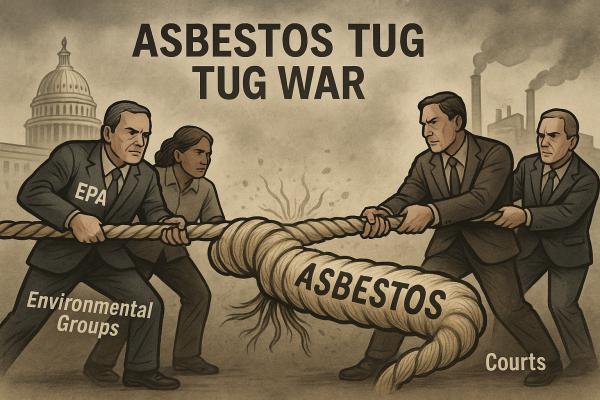
In January 2025, I wrote about how the battle to define “unreasonable risk” under the Chemical Safety Act (CSA) would become one of the key battles of the Trump Administration’s EPA. This prediction hit the mark, with the recent announcement that the EPA is reviewing its 2024 ban of chrysotile asbestos, the last type of asbestos used in the US.
The Chemical Safety Act
The Toxic Substances Control Act (TSCA), passed in 1976 and updated in 2016 with the Frank R. Lautenberg Chemical Safety Act (CSA), regulates both new chemicals entering the market and existing chemicals that pose a risk to human health and the environment. The CSA mandates a process for regulating existing chemicals that includes determining whether a chemical presents an “unreasonable risk of injury to health or the environment” under the conditions of use. This has led to successive administrations going back and forth on defining what constitutes an unreasonable risk.
Asbestos is the latest chemical in this back-and-forth tug of war.
- In 2020, the EPA released its final Part 1 of the Risk Evaluation for Asbestos, concluding that there are unreasonable risks to workers, occupational non-users, consumers, and bystanders from 16 out of 32 conditions of use.
- A court ruled that the EPA needed to supplement its Part 1 review of asbestos with a Part 2 risk evaluation because it had unlawfully excluded “legacy uses” and “associated disposal” for the conditions of use.
- In 2024, the EPA released its final Part 2 of the Risk Evaluation for Asbestos, concluding that asbestos poses an unreasonable risk to human health, including the disturbance and handling of asbestos associated with legacy uses.
- In March 2024, the EPA finalized Part 2 of the Risk Evaluation for Asbestos, and chrysotile asbestos became the first chemical banned under the CSA.
- Numerous appeals have been filed and consolidated and are pending in the Fifth Circuit Court of Appeals.
Which leads us to the present day, with the EPA's recent announcement that over the next 30 months, the EPA will reconsider the Biden administration’s ban on chrysotile asbestos, to determine whether parts of the ban
“went beyond what is necessary to eliminate the unreasonable risk and whether alternative measures – such as requiring permanent workplace protection measures – would eliminate the unreasonable risk.”
Why has asbestos been such a focus of the EPA?
I believe this is because of its potential impact on the seven other chemicals [1] evaluated under the CSA, found by the first Trump Administration not to pose an unreasonable risk. In 2022 and 2023, the Biden Administration reversed that decision, determining that all seven chemicals presented “an unreasonable risk”, using the rationale that one could not guarantee that the workers who were exposed to asbestos were using personal protective equipment (PPE) or using it correctly.
Suppose the current Trump Administration determines that the Biden Administration went beyond “what is reasonable” with asbestos, particularly given the assumption that PPE is not being used. In that case, it is not unreasonable to assume this could serve as the launching point for reviewing the other seven, more economically important chemicals. For example, in 2015, the US produced and imported approximately 142 million tons of carbon tetrachloride.
Additional Information on Asbestos
As previously discussed in an ACSH article, asbestos consists of a group of six different mineral fibers that naturally occur in rock and soil. [2] The predominant commercial form of asbestos is chrysotile, the only type of asbestos currently imported or used in manufacturing in the US. An estimated 150 tons were used in 2023, primarily imported from Brazil and Russia. The primary use of asbestos in the US today is by the chlor-alkali industry for generating chlorine in water purification. [3]
A typical water purification plant uses from 5 to 25 tons of asbestos each year in the production of chlorine. There is an asbestos-free process to produce chlorine – the membrane cell process - but many plants still use the asbestos process due to the time (approximately 1.5 to 2.5 years) and cost (40–50% of the cost of opening a new plant) required to convert existing plants.
The primary way people are exposed to asbestos is by breathing it in the air. Fibers with lengths greater than 5.0 microns (µm) are more likely to cause damage than fibers with smaller lengths. (A micron is equal to one millionth of a meter or about 0.000039 inches). Exposure to asbestos in drinking water is of secondary concern because asbestos levels in drinking water are generally quite low, and the EPA has set a drinking water regulation of 7 million fibers (longer than 10 microns) per liter of water.
There is almost universal consensus that asbestos causes cancer, with the International Agency for Research on Cancer (IARC) considering it Group 1, “carcinogenic to humans.” Workers who have been exposed to large amounts of asbestos have an increased risk of respiratory diseases, including fibrosis of the lung, cancer of the lung, and mesothelioma, an almost always fatal type of cancer of the thin membrane that surrounds the lungs and other organs. Workers can also develop different forms of cancer, including cancer of the stomach, intestines, and esophagus, but these are much less common.
Over the last few decades, the EPA has banned most uses of asbestos. In 1973, the EPA banned the use of spray-on asbestos in fireproofing and insulation, and extended the ban in 1978 to include additional products. Some older products still contain "legacy" asbestos, which is found in certain automotive parts, building materials, including cement sheets, fireproofing, and insulation.
The debate over the definition of “an unreasonable risk” is a significant policy issue. This battle isn’t about asbestos—it’s about setting the precedent for how chemical risks are evaluated, mitigated, and potentially overturned. If the definition of “unreasonable risk” shifts once again, it could unravel protections on far more economically significant chemicals, reshaping the future of chemical regulation in the US and beyond.
Note: As reported by the NY Times, the Trump Administration has reversed itself and will no longer seek to revise the ban on this final form of asbestos. We applaud both the outcry from the public, including myself, and the response of the Trump Administration.
[1] 1,4-Dioxane, 1-Bromopropane, Carbon tetrachloride, Methylene chloride, N-Methylpyrrolidone, Trichloroethylene, Perchloroethylene.
[2] Amosite (brown), Chrysolite (white), Chrocidolite (blue), Tremolite (silicic acid), Actinolite, Anthophyllite (azobolen).
[3] Chlorine is generated by passing electricity through saltwater. An asbestos barrier keeps the electrodes apart and stops the caustic soda made during the process from reacting with the chlorine.



